Discover 35 hidden attractions, cool sights, and unusual things to do in Antwerp (Belgium). Don't miss out on these must-see attractions: City Hall, Antwerp Zoo, and Plantin-Moretus Museum. Also, be sure to include Cathedral of Our Lady in your itinerary.
Below, you can find the list of the most amazing places you should visit in Antwerp (Vlaanderen).
Table of Contents
City Hall
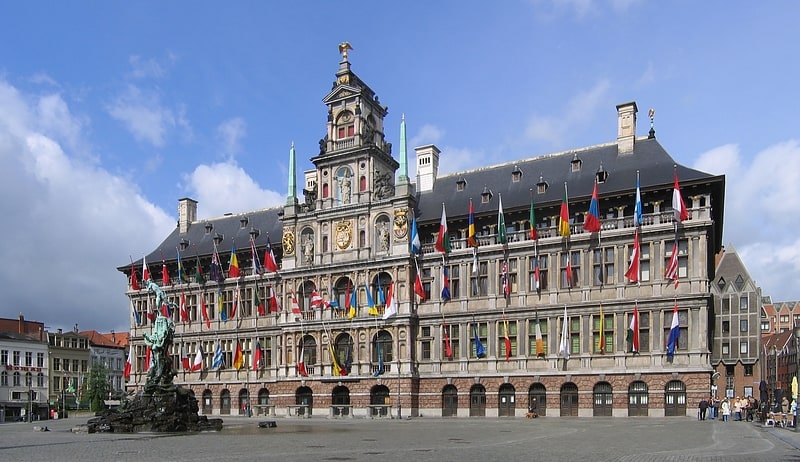
Also known as: Hôtel de ville d'Anvers
Building in Antwerp, Belgium. The City Hall of Antwerp, Belgium, stands on the western side of Antwerp's Grote Markt. Erected between 1561 and 1565 after designs made by Cornelis Floris de Vriendt and several other architects and artists, this Renaissance building incorporates both Flemish and Italian influences. The Stadhuis is listed as one of the Belfries of Belgium and France, a UNESCO World Heritage Site.[1]
Address: Grote Markt, 2000 Antwerp (Antwerpen)
Antwerp Zoo
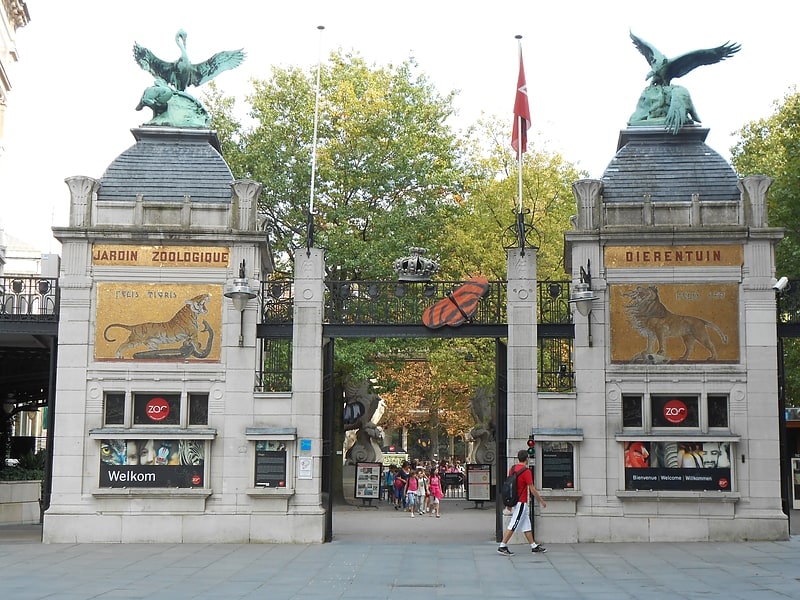
Also known as: Zoo d'Anvers
Animal park established in 1843. Antwerp Zoo is a zoo in the centre of Antwerp, Belgium, located next to the Antwerpen-Centraal railway station. It is the oldest animal park in the country, and one of the oldest in the world, established on 21 July 1843.[2]
Address: Koningin Astridplein 20-26, 2018 Antwerpen (Antwerpen)
Plantin-Moretus Museum
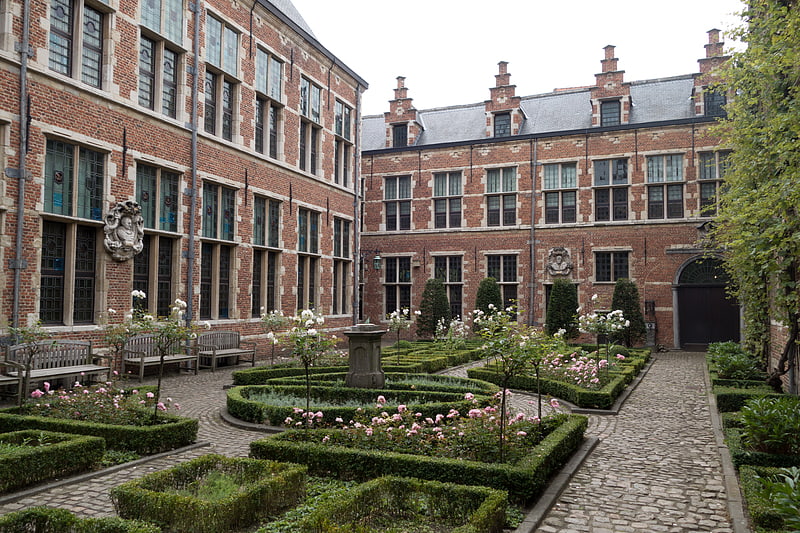
Also known as: Musée Plantin-Moretus
Museum of printing in 16th-century house. The Plantin-Moretus Museum is a printing museum in Antwerp, Belgium which focuses on the work of the 16th-century printers Christophe Plantin and Jan Moretus. It is located in their former residence and printing establishment, the Plantin Press, at the Vrijdagmarkt in Antwerp, and has been a UNESCO World Heritage Site since 2005.[3]
Address: Vrijdagmarkt 22-23, 2000 Antwerpen (Antwerpen)
Cathedral of Our Lady
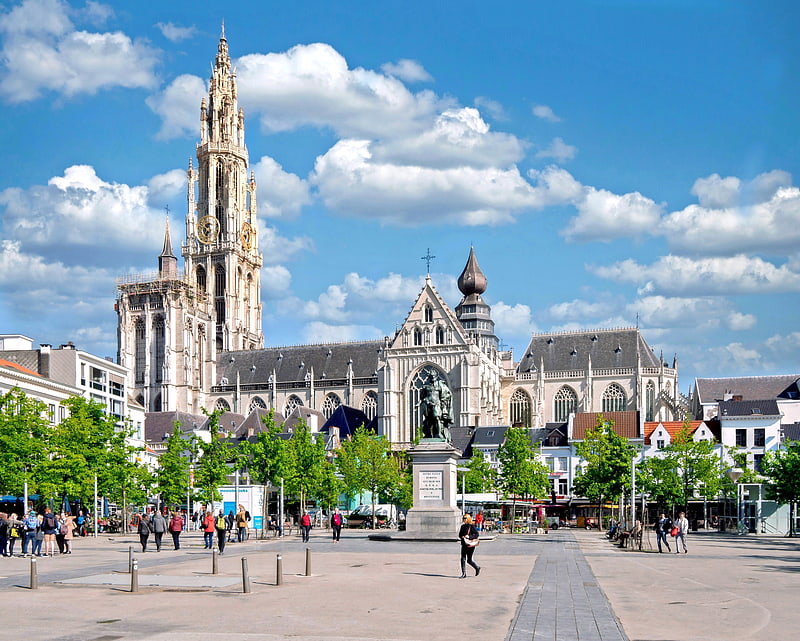
Also known as: Cathédrale Notre-Dame d'Anvers
Iconic 1300s edifice with art by Rubens. The Cathedral of Our Lady is a Roman Catholic cathedral in Antwerp, Belgium. Today's see of the Diocese of Antwerp started in 1352 and, although the first stage of construction was ended in 1521, has never been 'completed'. In Gothic style, its architects were Jan and Pieter Appelmans. It contains a number of significant works by the Baroque painter Peter Paul Rubens, as well as paintings by artists such as Otto van Veen, Jacob de Backer and Marten de Vos.
The belfry of the cathedral is included in the Belfries of Belgium and France entry in the list of UNESCO World Heritage Sites.[4]
Address: Groenplaats 21, 2000 Antwerpen (Antwerpen)
Brabo

Sculpture in Antwerp, Belgium. The Brabo Fountain is located in the Grote Markt of Antwerp, in front of the Town Hall of the city. The ceremonial inauguration of the sculpture took place in 1887. Jef Lambeaux realized the set of the bronze fountain.
The reason is the legend of the name of the city, in which it is said that the giant Druon Antigoon cut off a hand to all the ship captains who moored in the area and refused to pay toll, then throwing it to the Scheldt. The captain of the Roman army Brabo cut off the giant's hand imitating what he had done. The fountain reflects the moment when the Brabo throws the giant's hand into the river. According to this legend, the etymology of the name of the city Antwerp is a composition of the Dutch words "(h)ant" (hand) and "werpen" (launch).
However, John Lothrop Motley argues, and so do a lot of Dutch etymologists and historians, that Antwerp's name derives from "anda" (at) and "werpum" (wharf) to give an 't werf (on the wharf, in the same meaning as the current English wharf). Aan 't werp (at the warp) is also possible. This "warp" (thrown ground) is a man-made hill or a river deposit, high enough to remain dry at high tide, whereupon a construction could be built that would remain dry. Another word for werp is pol (dyke) hence polders (the dry land behind a dyke, that was no longer flooded by the tide).[5]
Maagdenhuis Museum
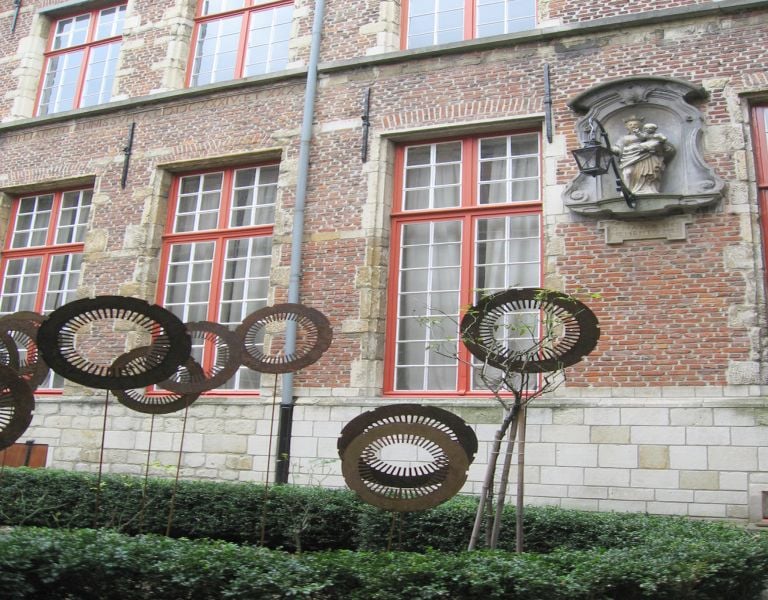
Museum in Antwerp, Belgium. The Maagdenhuis Museum is an art museum and historical museum located in a 17th-century historic building on Lange Gasthuisstraat, Antwerp, Belgium. The building was used as an orphanage for the maegdeckens, or maidens, from the mid-16th century to the end of the 19th century. The museum presents a collection of utensils used on a daily basis by the foundlings and the orphans; a collection of antique furniture, and a series of documents relating to the orphanage and the life in it from the 16th century to 19th century.
Although one of the smallest museums in Antwerp, the Maagdenhuis houses a valuable and rich collection of paintings and sculptures. The collection includes works by artists such as Peter Paul Rubens, Jacob Jordaens, Sir Anthony van Dyck, Pieter Aertsen, Otto van Veen, Simon De Vos, Maarten Pepijn, Hubert Van den Eynde, and Walter Pompe.[6]
Address: Lange Gasthuisstraat 33, 2000 Antwerpen (Antwerpen)
Sportpaleis

Also known as: Palais des sports d'Anvers
Arena in Antwerp, Belgium. The Antwerps Sportpaleis, also called Sportpaleis Antwerpen, Sportpaleis Merksem or simply the Sportpaleis, is an arena in Antwerp, Belgium. It is a multipurpose hall where concerts, sporting events, festivals and fairs are organized. The arena was built for sport, especially track cycling, but there is now little sport there, an exception being the Diamond Games tennis.
According to Billboard Magazine, the Sportpaleis is the second most visited event hall in the world, second only to Madison Square Garden. The Sportpaleis is known for performances by both Dutch-speaking and international artists. It also hosts the Nekka-Nacht, the Proximus Diamond Games tennis tournament for women and Pop Poll De Luxe, organised by the magazine HUMO.
The main building is 88 metres wide and 132 metres long and has a roof spanning 11.600 m². Under the stands, there is a wooden cycling track 250 meters long and 8 meters wide. The arena is elliptical and has two floors.
Next to the Sportpaleis is its sister venue the Lotto Arena, a hall that can accommodate 8,000 spectators.[7]
Address: Van Schijndelstraat 119, 2170 Antwerp
Het Steen
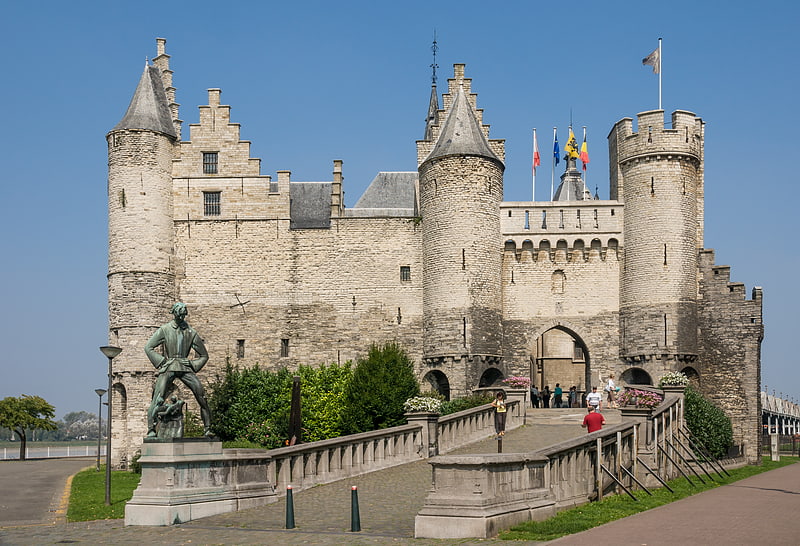
Also known as: Steen
Historical place in Antwerp, Belgium. Het Steen is a medieval fortress in the old city centre of Antwerp, Belgium, one of Europe's biggest ports. The surviving structure was built between 1200 and 1225 as a gateway to a larger castle of the Dukes of Brabant which was demolished in the 19th century. As the first stone fortress of Antwerp, Het Steen is Antwerp's oldest building and used to be its oldest urban centre. The words "Het Steen", are dutch for The Rock.
The first documented mention of Antwerp Castle dates back to the 12th century. However, there was a castle here as early as the Carolingian period in the 9th century. The first castle may have been built after the Viking incursions in the early Middle Ages; in 879 the Normans invaded Flanders. The Margraviate of Antwerp came into being around 974. The Duchy of Lower Lotharingia was part of the Holy Roman Empire, while on the opposite bank of the Scheldt lay the county of Flanders, which was subordinate to the king of France. From 1076 to 1100 Godfrey of Bouillon was the Margrave of Antwerp. Godfrey I, Count of Louvain, received the duchy in 1106. His great-grandson was Henry I, Duke of Brabant who received the Duchy of Brabant in 1183.
Previously known as Antwerpen Burcht (fortress), Het Steen gained its current name in around 1520, after significant rebuilding under Charles V. The rebuilding led to its being known first as "'s Heeren Steen" (the King's stone castle), and later simply as "Het Steen" (the stone castle). The Dutch word "steen" means "stone", and used to be used for "fortress" or "palace", as in the "Gravensteen" in Ghent, Belgium.
The fortress made it possible to control the access to the Scheldt, the river on whose bank it stands. It was used as a prison between 1303 and 1827. The largest part of the fortress, including dozens of historic houses and the oldest church of the city, was demolished in the 19th century when the quays were straightened to stop the silting up of the Scheldt. The remaining building, heavily changed, contains a shipping museum, with some old canal barges displayed on the quay outside.
In 1890 Het Steen became the museum of archeology and in 1952 an annex was added to house the museum of Antwerp maritime history, which in 2011 moved to the nearby Museum Aan de Stroom. Here is also a war memorial to the Canadian soldiers in World War II.
At the entrance to Het Steen is a bas-relief of Semini, above the archway, around 2nd century. Semini is the Scandinavian God of youth and fertility (with symbolic phallus). A historical plaque near Het Steen explains that women of the town appealed to Semini when they desired children; the god was reviled by later religious clergy. Inhabitants of Antwerp previously referred to themselves as "children of Semini". An organization concerned with the historic preservation of Het Steen and Semini, Antwerp Komitee Semini in Ere (AKSIE), formed in 1986, holds annual celebrations at Het Steen as cultural events.
At the entrance bridge to the castle is a statue of a giant and two humans. It depicts the giant Lange Wapper who used to terrorise the inhabitants of the city in medieval times.
Richard Wagner's opera Lohengrin, which premiered in 1850, is set in Antwerp Castle around the year 933 under the reign of Henry the Fowler, with Elsa von Brabant as the main female protagonist and the swan knight Lohengrin, who magically appears on the river on a barge pulled by a swan when the king holds court hearing on the bank. Ludwig II of Bavaria had Neuschwanstein Castle designed by stage designers in 1869; its narrow rectangular inner courtyard is designed according to Wagner's stage directions for Antwerp Castle, with Elsa's wing on the left including the covered balcony on which she stands at the beginning of the second act.[8]
Address: Steenplein 1, 2000 Antwerp (Antwerpen)
Rubenshuis
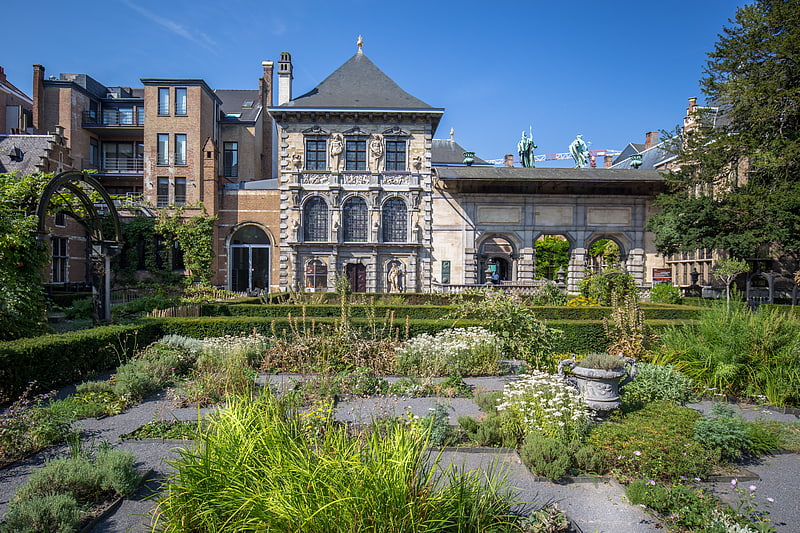
Also known as: Maison de Rubens
Museum in former mansion home of Rubens. The Rubenshuis is the former home and workshop of Peter Paul Rubens in Antwerp. Purchased in 1610, Rubens had the Flemish townhouse renovated and extended on the basis of designs by Rubens himself. After the renovations, the house and its courtyard garden had the outlook of an Italian palazzo, which reflected the artistic ideals of Rubens. The ensemble is now a museum dedicated mainly to the work of Rubens and his contemporaries.[9]
Address: Wapper 17, 2000 Antwerpen (Antwerpen)
Vleeshuis
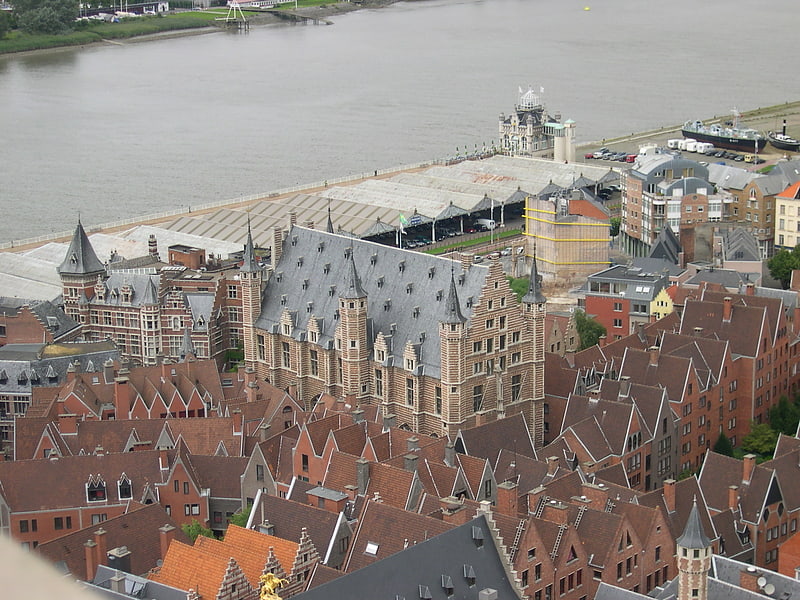
Museum in Antwerp, Belgium. The Vleeshuis in Antwerp, Belgium is a former guildhall. It is now a museum located between the Drie Hespenstraat, the Repenstraat and the Vleeshouwersstraat. The slope where the Drie Hespenstraat meets the Burchtgracht used to be known as the Bloedberg or Blood Mountain.[10]
Address: Vleeshouwersstraat 38, 2000 Antwerp (Antwerpen)
Museum Mayer van den Bergh
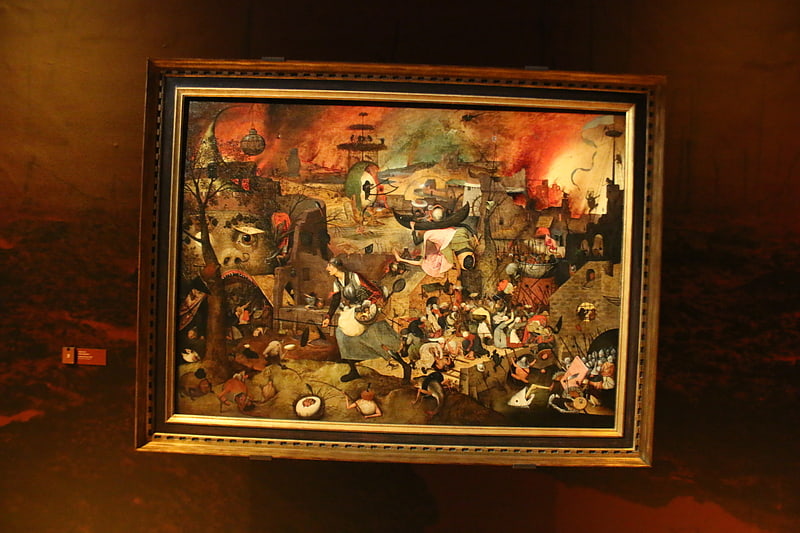
Also known as: Musée Mayer van den Bergh
Medieval artworks from the Low Countries. Museum Mayer van den Bergh is a museum in Antwerp, Belgium, housing the collection of the art dealer and collector Fritz Mayer van den Bergh. The major works are from the Gothic and Renaissance period in the Netherlands and Belgium, including paintings by Pieter Brueghel the Elder.[11]
Address: Lange Gasthuisstraat 19, 2000 Antwerpen (Antwerpen)
Groenplaats
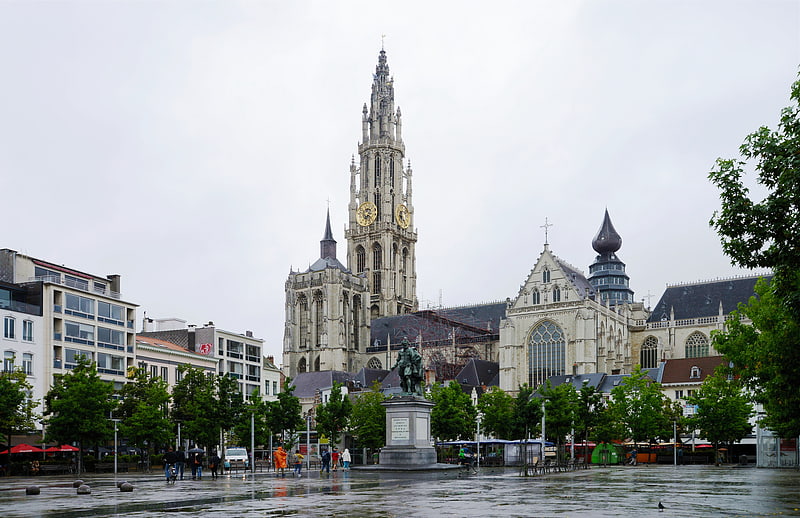
The Groenplaats is a large square in the center of the Belgian city of Antwerp, situated south of the Antwerp cathedral. There are various trees with benches on the square, which is a 'resting place'. A statue of Rubens, designed in 1840 and erected in 1843 by Willem Geefs, is in the center of the square. Adjacent lie many cafes as well as a Hilton hotel, located in the old Grand Bazar building. An underground parking garage and the Groenplaats metro station are situated underneath the square.[12]
Address: Groenplaats, Antwerp (Antwerpen)
Sint-Pauluskerk
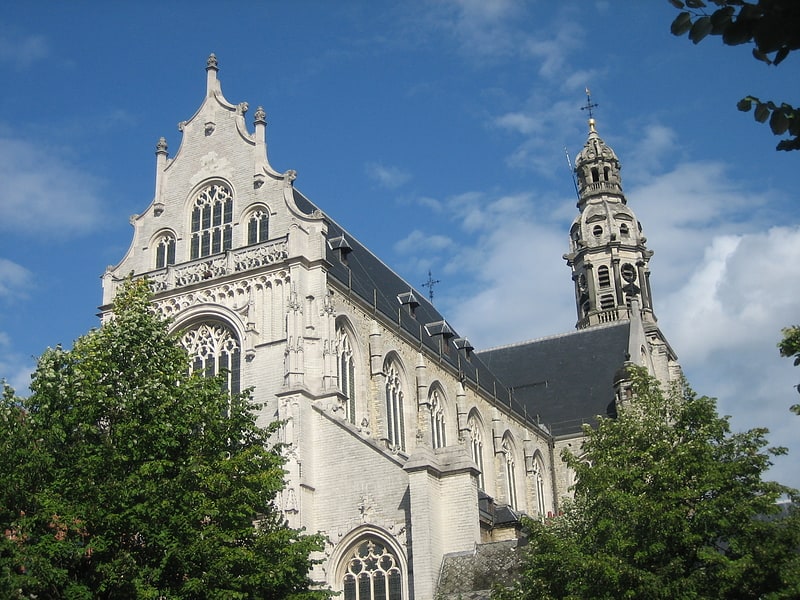
Also known as: Église Saint-Paul d'Anvers
Catholic church in Antwerp, Belgium. The St. Paul's Church or Sint-Pauluskerk is a Roman Catholic church located at the Veemarkt in Antwerp. Its exterior is mainly Gothic with a Baroque tower while the interior is characterised by its rich Baroque decoration. It holds paintings by Antwerp's leading artists Peter Paul Rubens, Anthony van Dyck and Jacob Jordaens as well as abundant sculpture and church furniture crafted by leading Antwerp sculptors such as Artus Quellinus the Elder, Pieter Verbrugghen I, Jan Pieter van Baurscheit de Elder, Jan Claudius de Cock and Andries Colyns de Nole. Of particular note is the Calvary outside the Church which is made up of 63 life-size statues and nine reliefs executed in a popular and theatrical style.[13]
Address: Sint-Paulusstraat 22, 2000 Antwerpen (Antwerpen)
DIVA
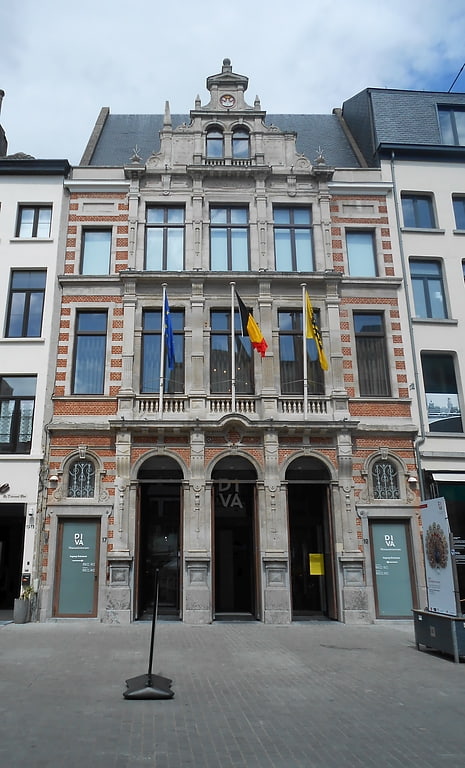
DIVA Museum for Diamonds, Jewellery and Silver is a museum that opened in Antwerp, Belgium, in 2018. It merged the collections of the former Antwerp Diamond Museum and Sterckshof silver museum in a single institution.
The museum's collection "features over 500 objects that detail the story of Antwerp's history with diamonds and gemstones".[14]
Address: 17-19 Suikerrui, Antwerp (Antwerpen)
Saint Carolus Borromeus church

Also known as: Église Saint-Charles-Borromée d'Anvers
Baroque church with changing altarpieces. St. Charles Borromeo Church is a church in central Antwerp, located on the Hendrik Conscience square. It was built in 1626 as the Jesuit church of Antwerp, which was closed in 1773. It was rededicated in 1779 to Saint Charles Borromeo. The church was formerly known for 39 ceiling pieces by Rubens that were lost in a fire when lightning struck the church on 18 July 1718.[15]
Address: Hendrik Conscienceplein 12, 2000 Antwerp (Antwerpen)
Bosuilstadion

Stadium in Antwerp, Belgium. The Bosuilstadion is an association football stadium in the city of Antwerp, Belgium. The stadium was opened in 1923 and has been the home of Royal Antwerp ever since. It has a capacity of 16,144, of which 800 are indoor VIP seats. It is located in the district of Deurne.
The Bosuilstadion hosted the 1964 European Cup Winners' Cup Final replay, which sealed the victory of Sporting Clube de Portugal against MTK Budapest FC. It also hosted the UEFA Euro 1972 semifinal between Belgium and West Germany, won by West Germany. Many friendly international games of Belgium were played at the Bosuil, many of which were against the Netherlands. However, the stadium has not hosted an international game since a friendly match Germany against Brazil in 1988.
A major reconstruction of the stadium started in 2017.[16]
Address: Oude Bosuilbaan 54, 2100 Antwerp
Queen Elisabeth Hall
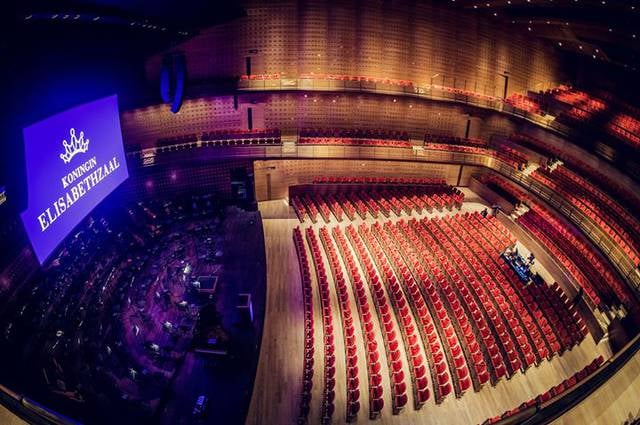
Concert hall in Antwerp, Belgium. The Queen Elisabeth Hall is a concert and event venue located at the Koningin Astridplein in Antwerp, Belgium. It has a capacity of 2,000 seats and the Antwerp Symphony Orchestra is its residential orchestra. The Queen Elisabeth Hall is part of the Elisabeth Center of Antwerp, managed by the Royal Zoological Society of Antwerp.[17]
Address: Koningin Astridplein 26, 2018 Antwerpen (Antwerpen)
Olympisch Stadion
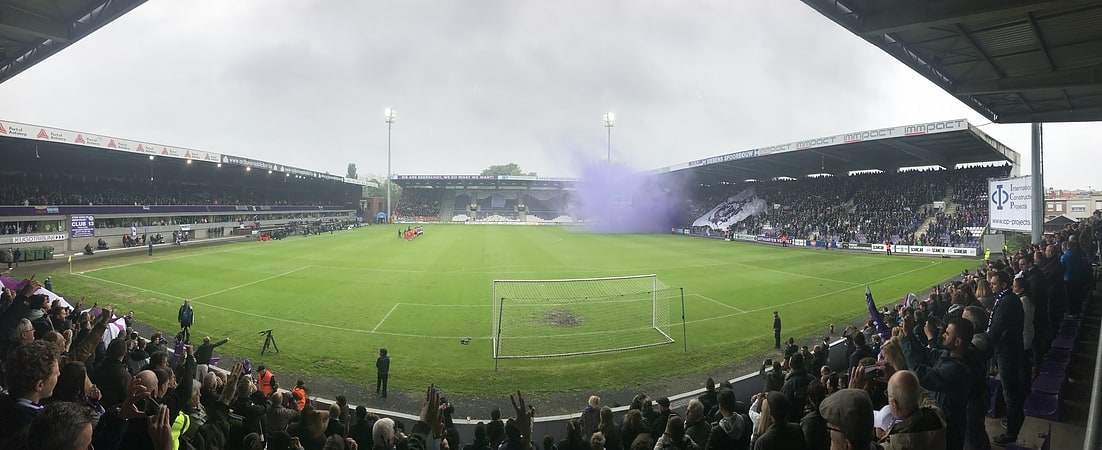
Also known as: Stade olympique d'Anvers
Stadium in Antwerp, Belgium. The Olympisch Stadion or Kielstadion) was built as the main stadium for the 1920 Summer Olympics in Antwerp. For those games, it hosted the athletics, equestrian, field hockey, football, gymnastics, modern pentathlon, rugby union, tug of war, weightlifting and korfball events. Following the Olympics it was converted to a football stadium. Its current tenant is K Beerschot VA, a Belgian football club. There are no remnants of the Olympic athletics track.
It is possible that Archibald Leitch was involved in the design of the stadium having made several visits prior to the Games.[18]
Address: Atletenstraat 80, 2020 Antwerpen (Antwerpen)
[MIDDELHEIMMUSEUM]
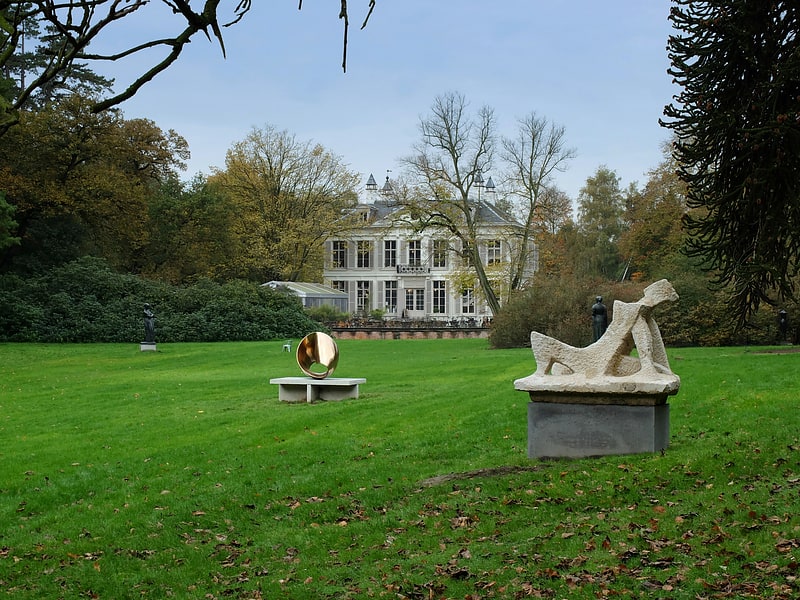
Also known as: Musée de Sculpture en plein air de Middelheim
Open-air modern art and sculpture park. Middelheim Open Air Sculpture Museum is a sculpture park of 30 acres in the park part of the Middelheim Nachtegalen Park at Antwerp. The Middelheim Museum collection has approximately 400 works of art on display. These include around 215 sculptures, featuring artists such as Carl Andre, Franz West, Auguste Rodin and many more. Along with the addition of new works every year, the museum invites contemporary artists to engage in an artistic conversation with works part of the permanent collection and the environment surrounding them, leading to the establishment of performances and exhibitions and by various kinds of artists. Works such as ones by Roman Signer and Ai Weiwei are also created specifically for the museum.
The museum includes the Braem pavilion, designed by the Belgian architect Renaat Braem. He is seen as a significant symbol for post-war architecture in Belgium and aimed to blur the boundaries between architecture and art. Reflective of this, Braem aimed to design the pavilion to incorporate a sculptural quality to organically merge it with the park’s landscape. The design developed into a set of closed pavilions and open patios, formulated “as nature would”, with an accessible entrance and a distinct roof structure to create an ever-changing spatial experience augmented by the flow of light through the pavilion. The rudimentary base was placed in 1969, and the pavilion was then officially introduced at the eleventh Biennial in 1971. Plans for construction around the pavilion were left unfinished with a fountain by Olivier Strebelle being the only trace, which speaks to the idea of merging architecture with nature as it embraces the idea of imperfection. (“The Braem Pavilion”) Another fountain by the Belgian artist Philippe Van Snick is placed in front of the pavilion. (“Middelheim Museum”)
The Braem Pavilion is exclusive to fragile works from the permanent collection, such as ones by Alberto Giacometti, Jean Arp, and Wim Delvoye, to maintain them suitably. The works exhibited at the pavilion change twice a year. (“Middelheim Museum”)
A 750-meter pathway begins at the Braem Pavilion and runs past the Middelheim Castle and over Middelheimlaan to ‘Hortiflora’, a botanical flower garden part of Nachtegalenpark until it was added to the Middelheim Museum in 2012. With this inclusion, the museum covers more than thirty hectares of park and exhibition area. (“Middelheim Museum”)
The merging of art and nature is a significant aspect of the museum. This is seen through the displayed works, the kinds of exhibitions curated and the pavilions and structure of the open-aired museum itself. In the works exhibited, their placement is just as important as the works themselves because the intermingling of the works with their natural surroundings transforms and augments the experience of the viewer.[19]
Address: Middelheimlaan 61, 2020 Antwerpen (Antwerpen)
Museum aan de Stroom
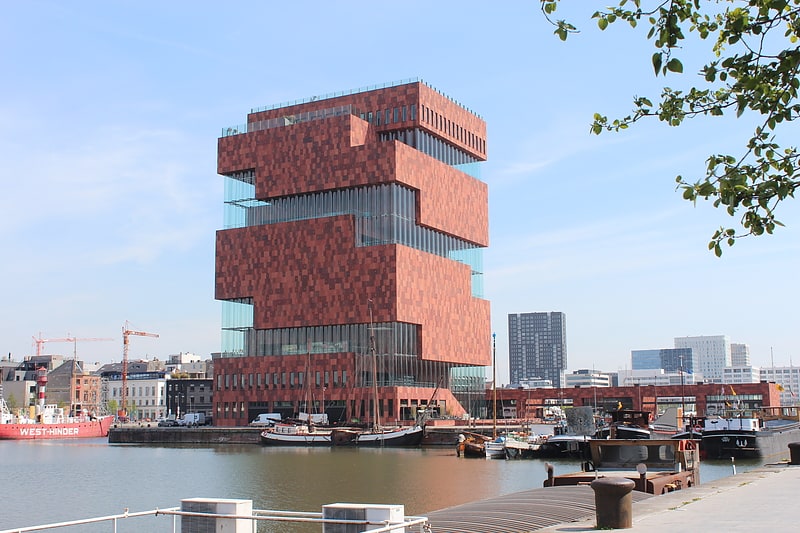
Modern museum exploring city's heritage. The Museum aan de Stroom is a museum located along the river Scheldt in the Eilandje district of Antwerp, Belgium. It opened in May 2011 and is the largest museum in Antwerp.[20]
Address: Hanzestedenplaats 1, 2000 Antwerpen (Antwerpen)
Letterenhuis

Also known as: Maison des lettres
Archive of Flemish writing with a museum. The Letterenhuis is a Belgian non-profit organization located in Antwerp. The Letterenhuis collects and archives information of Flemish writers and artists, and portraits concerning Flemish culture as from 1750. The Letterenhuis fulfills two tasks: on the one hand it is an archiving and documentation centre and on the other hand it is a museum. The most interesting part of its collection are the manuscripts of famous Belgian authors like Hendrik Conscience, Willem Elsschot and the contemporary writer Tom Lanoye. In 2012 the Letterenhuis featured a theme exhibition about Louis Paul Boon to honor his one hundredth birth year.[21]
Address: Minderbroedersstraat 22, 2000 Antwerp (Antwerpen)
Fotomuseum Antwerp
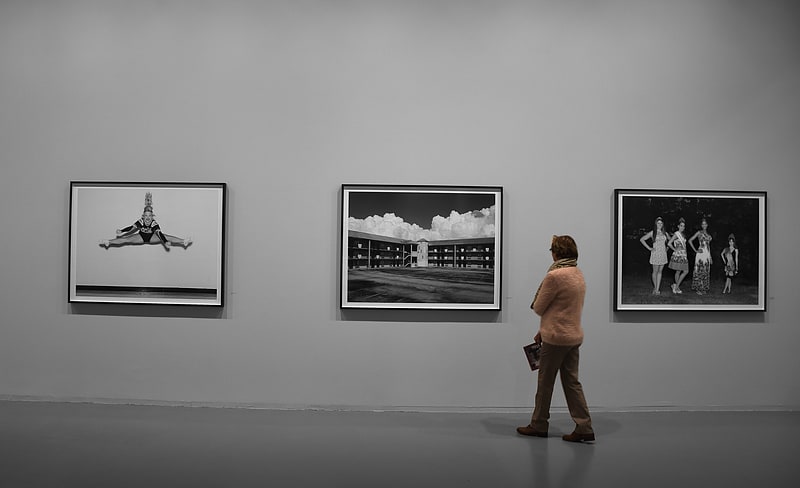
Also known as: Musée de la photographie d'Anvers
Museum in Antwerp, Belgium. Fotomuseum Antwerp, also known as FOMU, is a museum of photography in Antwerp, Belgium.[22]
Address: Waalsekaai 47, 2000 Antwerpen (Antwerpen)
Aquatopia

Aquarium in Antwerp, Belgium. Aquatopia was a popular educational attraction in central Antwerp, Belgium. It used to feature a set of aquariums, along with recreations of other marine habitats, including swamps, rain forests, river deltas, and coral reefs. Aquatopia also included a number of special exhibits covering sharks, nautilus, and mysteries of the deep. The multi-story attraction was located on Koningin Astridplein, opposite Antwerpen-Centraal railway station. It had 1,000,000 litres of water.[23]
Address: Koningin Astridplein 7, 2018 Antwerp (Antwerpen)
Koninklijk Museum voor Schone Kunsten Antwerpen
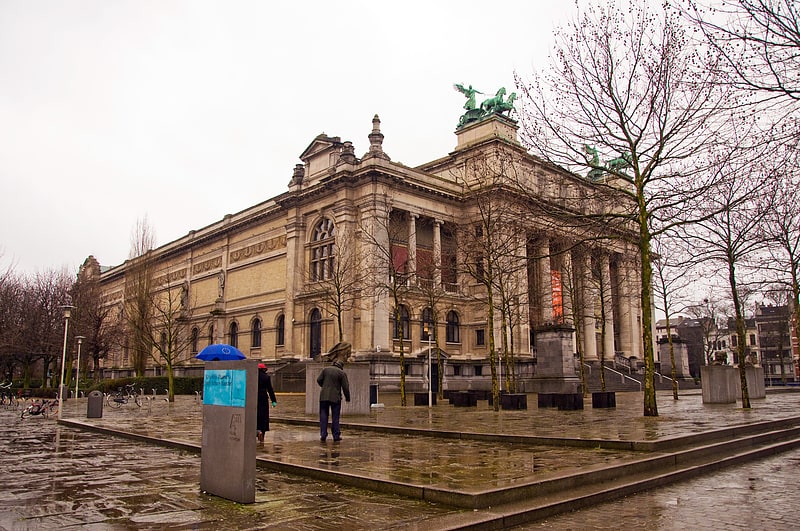
Also known as: Musée royal des beaux-arts d'Anvers
Museum in Antwerp, Belgium. The Royal Museum of Fine Arts Antwerp is a museum in Antwerp, Belgium, founded in 1810, houses a collection of paintings, sculptures and drawings from the fourteenth to the twentieth centuries. This collection is representative of the artistic production and the taste of art enthusiasts in Antwerp, Belgium and the Northern and Southern Netherlands since the 15th century. The museum has been closed for renovation since 2011.
The neoclassical building housing the collection is one of the primary landmarks of the Zuid district of Antwerp. The majestic building was designed by Jean-Jacques Winders (1849–1936) and Frans Van Dijk (1853–1939), built beginning in 1884, opened in 1890, and completed in 1894. Sculpture on the building includes two bronze figures of Fame with horse-drawn chariots by sculptor Thomas Vincotte, and seven rondel medallions of artists that include Boetius à Bolswert, Frans Floris, Jan van Eyck, Peter Paul Rubens, Quentin Matsys, Erasmus Quellinus II, and Appelmans, separated by four monumental sculptures representing Architecture, Painting, Sculpture, and Graphics.
The building stands in gardens bounded by the Leopold de Waalplaats, the Schildersstraat, the Plaatsnijdersstraat, and the Beeldhouwersstraat, formerly the site of the Antwerp Citadel.[24]
Address: Leopold de Waelplaats 1, 2000 Antwerpen (Antwerpen)
ModeMuseum Antwerpen

Also known as: Musée de la mode d'Anvers
Museum of designer and historical fashion. MoMu is the fashion museum of the City of Antwerp, Belgium. Founded on 21 September 2002, the museum collects, conserves, studies and exhibits Belgian fashion. The museum is specifically focusing on Belgian contemporary fashion designers due to the arising of a group of Antwerp-trained fashion designers during the Eighties and Nineties. The museum's first director was Linda Loppa who was also the founder and the director of the Fashion school of the Royal Academy of Fine Arts. The current director is Kaat Debo.[25]
Address: Nationalestraat 28, 2000 Antwerpen (Antwerpen)
Kinepolis Antwerpen
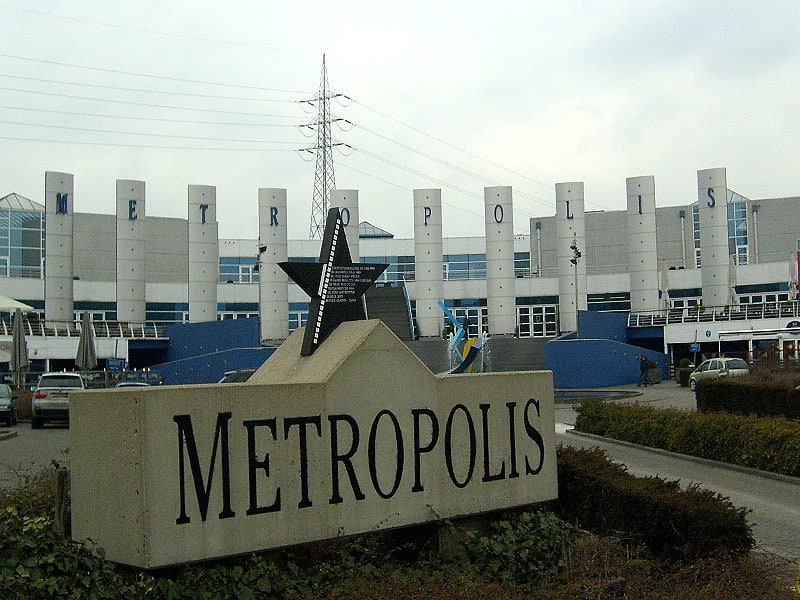
Nightlife, Cinema, Entertainment
Address: Groenendaallaan 412, 2030 Antwerpen (Antwerpen)
M HKA
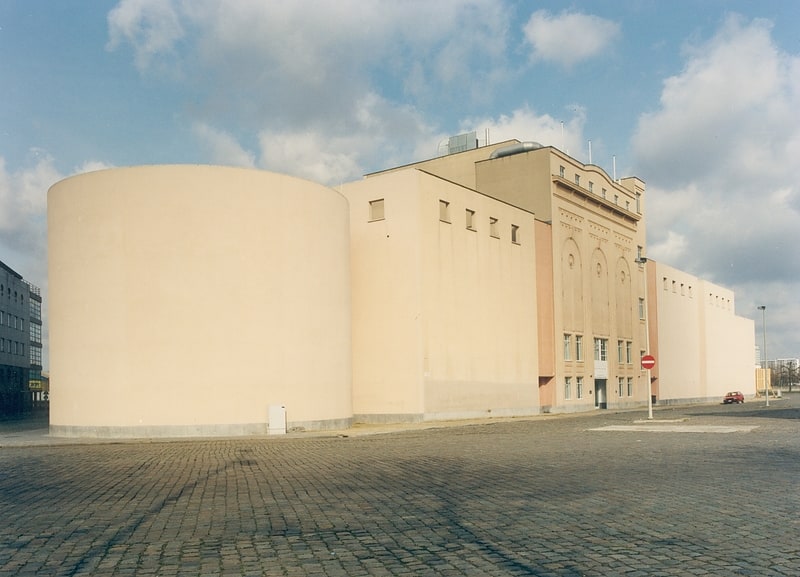
Also known as: Musée d'art contemporain d'Anvers
Contemporary, multimedia art museum. The Museum of Contemporary Art in Antwerp is the contemporary art museum of the city of Antwerp, Belgium. Its current director is Bart de Baere.[26]
Address: Leuvenstraat 32, 2000 Antwerp (Antwerpen)
Nachtegalenpark
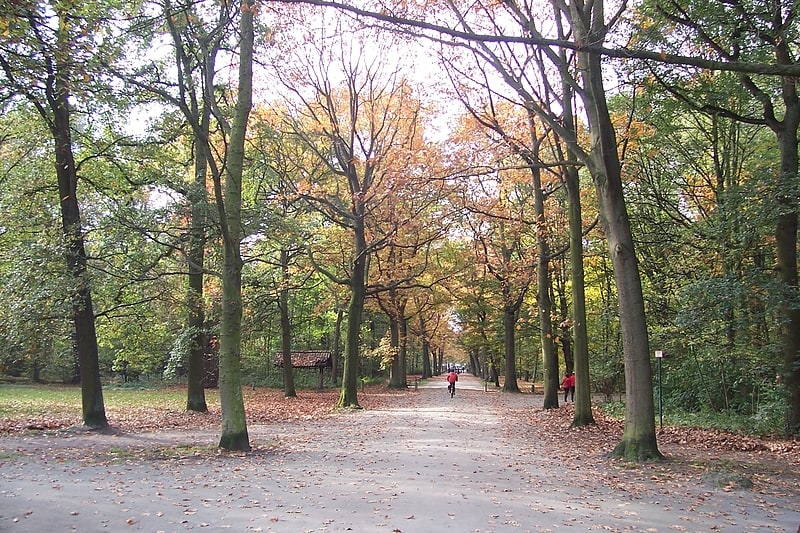
Park in Antwerp, Belgium. Nachtegalen Park is a park located in the Antwerp, Belgium municipality of Wilrijk. It served as the archery venue for the 1920 Summer Olympics.
During World War II, the park was headquarters for the 89th German Army Corps, then it became command post of the 719th Infantry Division.
The park is home to the Atlantic Wall & Air War Bunker Museum.[27]
The Mad Maiden
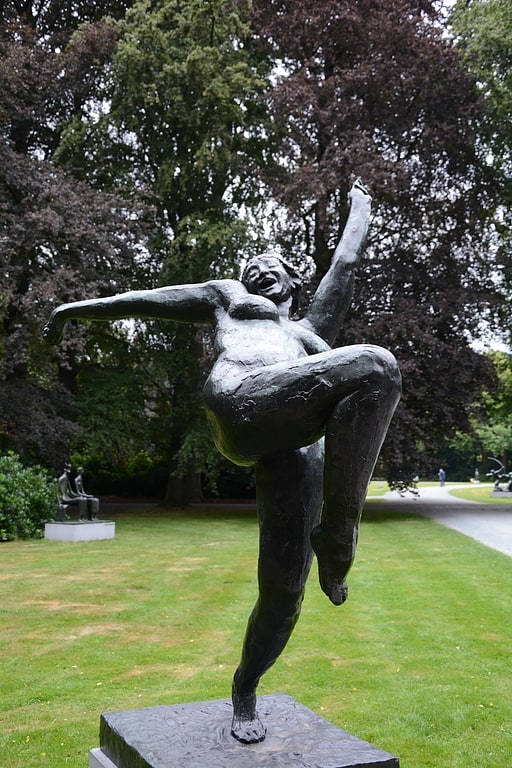
The Mad Maiden or The Mad Virgin is a bronze statue by the Belgian artist Rik Wouters, created in 1912.
The statue depicts Wouters' wife and muse, Nel Deurinckx, in a dynamic and ecstatic dancing pose. Wouters very often painted, drew and sculpted his wife in charming, everyday settings, while she was sleeping, reading, or doing domestic chores. The Mad Maiden is exceptional because it shows her in such an unusually carefree way. With this sensual sculpture, Wouters clearly distanced himself from the emotionlessness of academic art of his time.
Wouters became inspired for this sculpture when he and Nel visited a 1907 performance by the American modern dance pioneer Isadora Duncan in the Muntschouwburg in Brussels.
Several copies of the sculpture were made, also after the artist's early death in 1916. Casts of the sculpture are part of the following art collections:
- Middelheimmuseum, Antwerp, Belgium (on loan from the Royal Museum of Fine Art Antwerp)
- Belfius Art Collection, Brussels, Belgium
- Musée d'Ixelles, Brussels, Belgium
- Le Musée en Plein Air du Sart-Tilman, Liège, Belgium
Schoonselhof cemetery
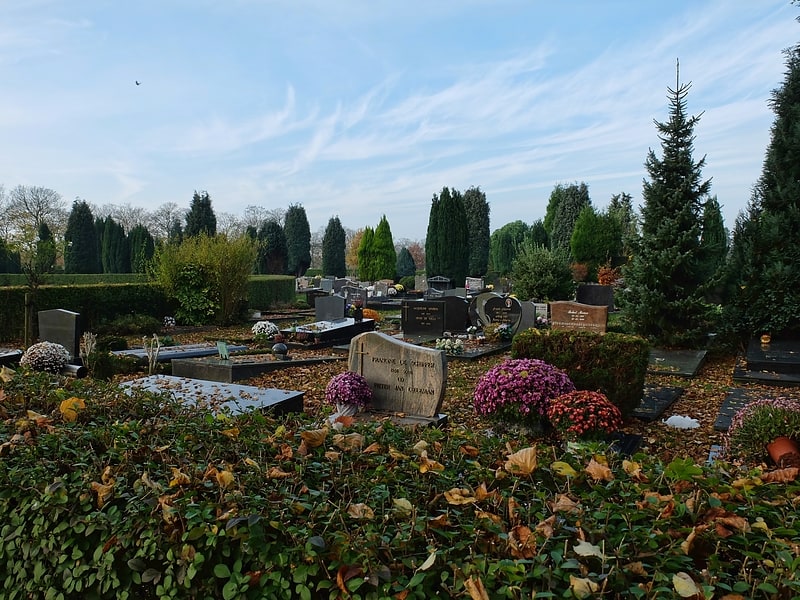
Cemetery in Antwerp, Belgium. Schoonselhof Cemetery is located in Hoboken, Antwerp, a suburb of Antwerp, Belgium.
Schoonselhof Cemetery has an islamic and Jewish section.
There is also a Commonwealth war graves plot containing the graves of 1,557 British Commonwealth service personnel who died in the World Wars, 101 from World War I and 1,455 from World War II, besides 16 Polish and 1 French war burial, a United States airman attached to the British Royal Air Force, and 16 non-war graves, mainly of merchant seamen. The plot was laid out by the Commission's Principal Architect, Philip Hepworth.
The cemetery was mentioned in the TV show GRIMM, Episode 14 of Season 1.[29]
Palace of Justice
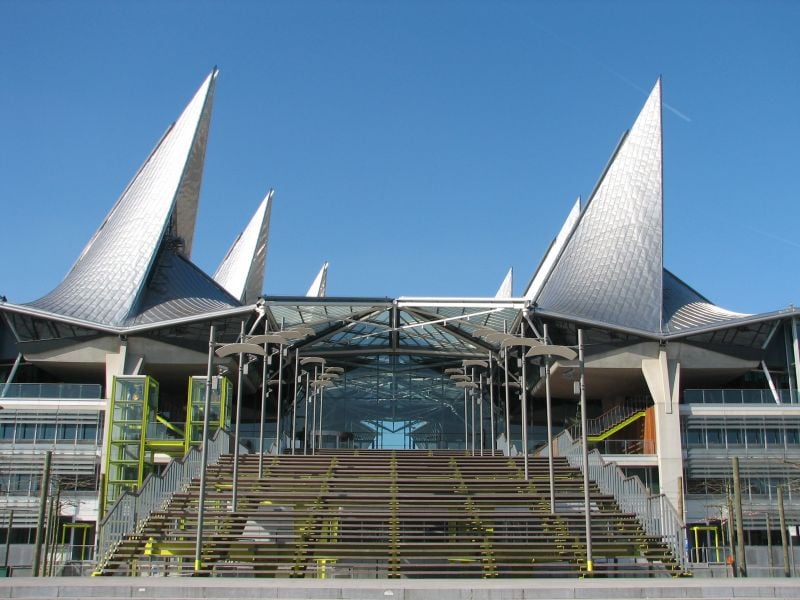
The Palace of Justice Antwerp commonly known as the Antwerp Law Courts, De Frietzakskes, and the Butterfly Palace, is a law court building located in the Belgium city of Antwerp on the site of the old Antwerp-South railway station. The building was built over the Bolivar Tunnel and it houses eight district civil and criminal courts. It was inaugurated on 28 March 2006 by King Albert, Minister of Justice Laurette Onkelinx, Minister of Finance Didier Reynders, governor Camille Paulus and mayor Patrick Janssens. The building was designed by the Richard Rogers Partnership, VK Studio and Arup.[30]
Address: 20 Bolivarplaats, Antwerp (Antwerpen)
St. James' Church

Landmark Gothic church with Rubens' tomb. St. James' Church is a former Collegiate church in Antwerp, Belgium. The church is built on the site of a hostel for pilgrims to Santiago de Compostela. The present building is the work of the Waghemakere family and Rombout Keldermans, in Brabantine Gothic style. The church contains the grave of Peter Paul Rubens in the eastern chapel.[31]
Address: Lange Nieuwstraat 73, 2000 Antwerpen (Antwerpen)
DeSingel

Music hall in Antwerp, Belgium. deSingel is a Belgian arts center. It is located on the Desguinlei in Antwerp. Its various stages, concert halls and exhibition spaces offer a manifold program of music, dance, theater and architecture. It is also home to the Royal Conservatory of Antwerp, the Flemish Architecture Institute, the Study Center for Flemish Music, the VDAB employment initiative for theatre technicians Sabbattini, the Eastman dance company, ChampdAction, I Solisti, detheatermaker and the Spiegel String Quartet.[32]
Address: 25 Desguinlei, Antwerp (Antwerpen)
Rockox House
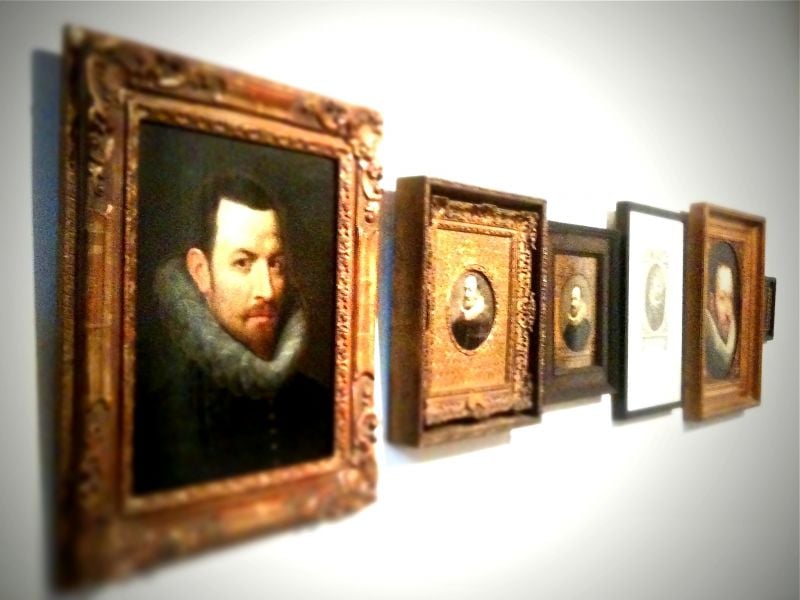
Museum in Antwerp, Belgium. The Rockox House is a former residence of the Rockox family and now a museum owned by KBC Bank in the city of Antwerp, Belgium.[33]
Address: Keizerstraat 12, 2000 Antwerp (Antwerpen)
Sterckshof

Castle in Antwerp, Belgium. The Sterckshof castle is in Deurne, Antwerp, Belgium. From 1994 to 2014 it housed the Sterckshof silver museum of the Province of Antwerp. Built on the site of a much older castle, or great house, the present building is a reconstruction erected in the 1920s.[34]
Address: 160 Hooftvunderlei, Antwerp